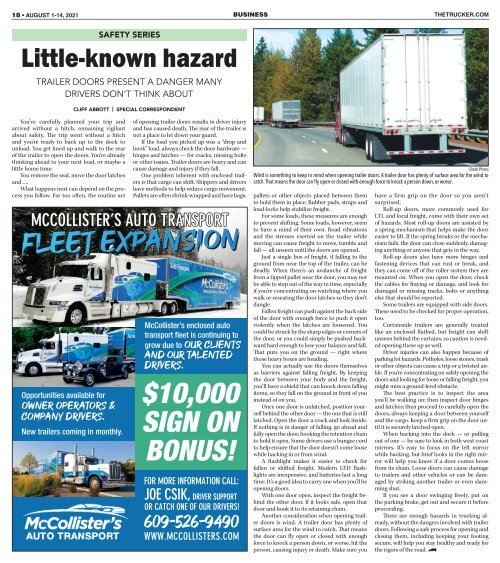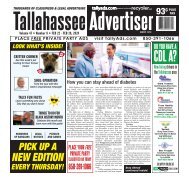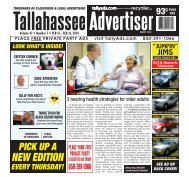You also want an ePaper? Increase the reach of your titles
YUMPU automatically turns print PDFs into web optimized ePapers that Google loves.
18 • AUGUST 1-14, 2021 BUSINESS<br />
THETRUCKER.COM<br />
SAFETY SERIES<br />
Little-known hazard<br />
TRAILER DOORS PRESENT A DANGER MANY<br />
DRIVERS DON’T THINK ABOUT<br />
CLIFF ABBO<strong>TT</strong> | SPECIAL CORRESPONDENT<br />
You’ve carefully planned your trip and<br />
arrived without a hitch, remaining vigilant<br />
about safety. The trip went without a hitch<br />
and you’re ready to back up to the dock to<br />
unload. You get lined up and walk to the rear<br />
of the trailer to open the doors. You’re already<br />
thinking ahead to your next load, or maybe a<br />
little home time.<br />
You remove the seal, move the door latches<br />
and ….<br />
What happens next can depend on the process<br />
you follow. Far too often, the routine act<br />
MCCOLLISTER’S AUTO TRANSPORT<br />
Fleet expansion<br />
Opportunities available for<br />
OWNER OPERATORS &<br />
COMPANY DRIVERS.<br />
New trailers coming in monthly.<br />
of opening trailer doors results in driver injury<br />
and has caused death. The rear of the trailer is<br />
not a place to let down your guard.<br />
If the load you picked up was a “drop and<br />
hook” load, always check the door hardware —<br />
hinges and latches — for cracks, missing bolts<br />
or other issues. Trailer doors are heavy and can<br />
cause damage and injury if they fall.<br />
One problem inherent with enclosed trailers<br />
is that cargo can shift. Shippers and drivers<br />
have methods to help reduce cargo movement.<br />
Pallets are often shrink-wrapped and have bags,<br />
McCollister’s enclosed auto<br />
transport fleet is continuing to<br />
grow due to OUR CLIENTS<br />
AND OUR TALENTED<br />
DRIVERS.<br />
$10,000<br />
SIGN ON<br />
BONUS!<br />
FOR MORE INFORMATION CALL:<br />
JOE CSIK, DRIVER SUPPORT<br />
OR CATCH ONE OF OUR DRIVERS!<br />
609-526-9490<br />
WWW.MCCOLLISTERS.COM<br />
iStock Photo<br />
Wind is something to keep in mind when opening trailer doors. A trailer door has plenty of surface area for the wind to<br />
catch. That means the door can fly open or closed with enough force to knock a person down, or worse.<br />
pallets or other objects placed between them<br />
to hold them in place. Rubber pads, straps and<br />
load-locks help stabilize freight.<br />
For some loads, these measures are enough<br />
to prevent shifting. Some loads, however, seem<br />
to have a mind of their own. Road vibrations<br />
and the stresses exerted on the trailer while<br />
moving can cause freight to move, tumble and<br />
fall — all unseen until the doors are opened.<br />
Just a single box of freight, if falling to the<br />
ground from near the top of the trailer, can be<br />
deadly. When there’s an avalanche of freight<br />
from a tipped pallet near the door, you may not<br />
be able to step out of the way in time, especially<br />
if you’re concentrating on watching where you<br />
walk or reseating the door latches so they don’t<br />
dangle.<br />
Fallen freight can push against the back side<br />
of the door with enough force to push it open<br />
violently when the latches are loosened. You<br />
could be struck by the sharp edges or corners of<br />
the door, or you could simply be pushed backward<br />
hard enough to lose your balance and fall.<br />
That puts you on the ground — right where<br />
those heavy boxes are heading.<br />
You can actually use the doors themselves<br />
as barriers against falling freight. By keeping<br />
the door between your body and the freight,<br />
you’ll have a shield that can knock down falling<br />
items, so they fall on the ground in front of you<br />
instead of on you.<br />
Once one door is unlatched, position yourself<br />
behind the other door — the one that is still<br />
latched. Open the door a crack and look inside.<br />
If nothing is in danger of falling, go ahead and<br />
fully open the door, hooking the retention chain<br />
to hold it open. Some drivers use a bungee cord<br />
to help ensure that the door doesn’t come loose<br />
while backing in or from wind.<br />
A flashlight makes it easier to check for<br />
fallen or shifted freight. Modern LED flashlights<br />
are inexpensive, and batteries last a long<br />
time. It’s a good idea to carry one when you’ll be<br />
opening doors.<br />
With one door open, inspect the freight behind<br />
the other door. If it looks safe, open that<br />
door and hook it to its retaining chain.<br />
Another consideration when opening trailer<br />
doors is wind. A trailer door has plenty of<br />
surface area for the wind to catch. That means<br />
the door can fly open or closed with enough<br />
force to knock a person down, or worse, hit the<br />
person, causing injury or death. Make sure you<br />
have a firm grip on the door so you aren’t<br />
surprised.<br />
Roll-up doors, more commonly used for<br />
LTL and local freight, come with their own set<br />
of hazards. Most roll-up doors are assisted by<br />
a spring mechanism that helps make the door<br />
easier to lift. If the spring breaks or the mechanism<br />
fails, the door can close suddenly, damaging<br />
anything or anyone that gets in the way.<br />
Roll-up doors also have more hinges and<br />
fastening devices that can rust or break, and<br />
they can come off of the roller system they are<br />
mounted on. When you open the door, check<br />
the cables for fraying or damage, and look for<br />
damaged or missing tracks, bolts or anything<br />
else that should be reported.<br />
Some trailers are equipped with side doors.<br />
These need to be checked for proper operation,<br />
too.<br />
Curtainside trailers are generally treated<br />
like an enclosed flatbed, but freight can shift<br />
unseen behind the curtains, so caution is needed<br />
opening these up as well.<br />
Driver injuries can also happen because of<br />
parking lot hazards. Potholes, loose stones, trash<br />
or other objects can cause a trip or a twisted ankle.<br />
If you’re concentrating on safely opening the<br />
doors and looking for loose or falling freight, you<br />
might miss a ground-level obstacle.<br />
The best practice is to inspect the area<br />
you’ll be walking on; then inspect door hinges<br />
and latches; then proceed to carefully open the<br />
doors, always keeping a door between yourself<br />
and the cargo. Keep a firm grip on the door until<br />
it is securely latched open.<br />
When backing into the dock — or pulling<br />
out of one — be sure to look in both west coast<br />
mirrors. It’s easy to focus on the left mirror<br />
while backing, but brief looks in the right mirror<br />
will help you know if a door comes loose<br />
from its chain. Loose doors can cause damage<br />
to trailers and other vehicles or can be damaged<br />
by striking another trailer or even slamming<br />
shut.<br />
If you see a door swinging freely, put on<br />
the parking brake, get out and secure it before<br />
proceeding.<br />
There are enough hazards in trucking already,<br />
without the dangers involved with trailer<br />
doors. Following a safe process for opening and<br />
closing them, including keeping your footing<br />
secure, will help you stay healthy and ready for<br />
the rigors of the road. 8

















